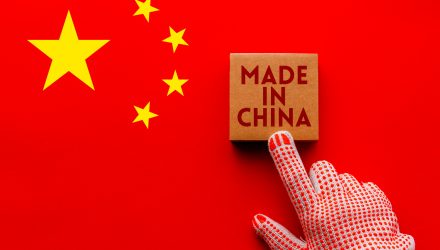Activity in China’s manufacturing sector saw an uptick during the month of March, helping to ease fears of a global economic slowdown and boosted exchange-traded funds (ETFs) like the VanEck Vectors ChinaAMC CSI 300 ETF (NYSEArca: PEK), VanEck Vectors ChinaAMC SME-ChiNext ETF (NYSEArca: CNXT) and the iShares China Large-Cap ETF (NYSEArca: FXI).
As of 1:15 p.m. ET, PEK was up 0.73 percent, CNXT rose 4.48 percent and FXI was up 1.40 percent.
Chinese factories showed a marked increase in activity, according to the official purchasing managers index released Sunday. The index rose to a six-month high of 50.5 during the month of March–from 49.2 in February, which bested economists’ forecasts.
“It’s beyond seasonal,” said Shuang Ding, an economist at Standard Chartered. “Such strong readings reflect both seasonal effects and support measures.”
While ongoing trade negotiations between the U.S. and China have the capital markets eagerly anticipating a tangible trade deal, stimulus measures by the Chinese government to prop up the domestic economy are starting to take its effect.
A mix of Chinese stimulus measures have been providing the fodder for economic growth, such as lower taxes, no corporate tax breaks, monetary policy adjustments, and more market access for foreign companies to set up shop. All in all, Wall Street is looking at the Chinese government’s latest efforts as a plus for its economy and a boon for China ETFs.
“We don’t see a reason why the global economy can’t continue to advance at a slow and steady pace,” said Craig Birk, chief investment officer at Personal Capital.
Related: $13T Chinese Bond Market Makes Debut on Major Global Index
In addition, China is becoming less resistant to safeguarding its businesses, which will open the pathways to more foreign investment. China ETFs have also been the beneficiaries of index provider MSCI Inc. announcing recently that it would quadruple its weighting of large-cap Chinese shares in its benchmark indexes.
A recent MSCI Inc. press release said the index provider would increase the weight of China A shares by upping the inclusion factor from 5 percent to 20 percent.
“There are a lot of companies on mainland China that just recently, because Chinese laws have loosened up, that have allowed investors outside of the U.S. to invest in Chinese stocks,” said ETF Trends CEO Tom Lydon.
As such, one ETF to consider is the Xtrackers Harvest CSI 300 China A ETF (NYSEArca: ASHR) as a way for investors to gain exposure to China’s biggest, best and most authentic equities. ASHR was up 0.5 percent on Monday and up 31 percent YTD.
ASHR seeks investment results that track the CSI 300 Index that is designed to reflect the price fluctuation and performance of the China A-Share market. In essence, it’s composed of the 300 largest and most liquid stocks in the China A-Share market, including small-cap, mid-cap, and large-cap stocks.
Without a majority of its holdings in state-owned enterprises compared to FXI, ASHR provides a more authentic and diversified representation of gaining access to the world’s second largest economy.
“This is the best way to actually get into China and invest in real companies that are not state-owned,” said Lydon.
For more market trends, visit ETF Trends.








